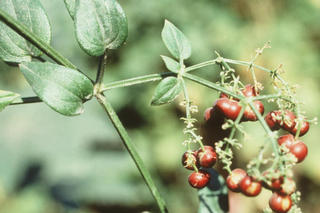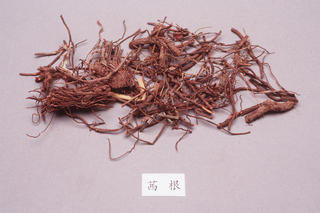Rubia cordifolia
Contents
- 1 Nomenclature
- 2 Historical Use of Rubia cordifolia
- 3 Background
- 4 Nomenclature
- 5 Historical Use of Rubia cordifolia
- 6 Background
- 7 Nomenclature
- 8 Historical Use of Rubia cordifolia
- 9 Background
- 10 Nomenclature
- 11 Historical Use of Rubia cordifolia
- 12 Background
- 13 Nomenclature
- 14 Historical Use of Rubia cordifolia
- 15 Background
- 16 Nomenclature
- 17 Historical Use of Rubia cordifolia
- 18 Background
- 19 Pharmaceutical Information
- 20 Evidence or the Use of Rubia cordifolia in the Treatment of Epilepesy
- 21 Safety
Nomenclature
Other Names:
Historical Use of Rubia cordifolia
Rubia cordifolia in Traditional Chinese Medicine
Background
Chinese Name (pinyin): Qiancao
Chinese Name :
Common Name :India Madder Root
Specific Name : Herba rubiae
Scientific Name:
Collection : The drug is collected in spring and summer, removed from soil and dry.
Description : Rhizome nodular, marked with numerous fascilcled roots varying in thickness. Roots cylindrical, somewhat curved, 10 - 25 cm long, 0.2 - 1 cm in diameter, externally reddish brown or dark brown with fine longitudinal wrinkles and a few rootlet scars. The place where the outer bark has exfoliated appearing yellowish red. Texture fragile, easily broken, fracture even, bark narrow and purplish red, wood broad, pale yellowish red, exhibiting numerous pores of vessels. Odourless, taste bitterish with an irritating sensation to the tongue when chewed for a long time.
Identification : 1.Transverse section of the root: Cork cells 6 - 12 layered containing brown contents. Parenchymatous cells in cortex sometimes containing reddish brown granules. Cells in phloem relatively small. Cambium ring less distinct. The majority of root occupied by wood, completely lignified, xylem rays indistinct. Parenchymatous cells containing raphides of calcium oxalate.2.Shake 0.2 g of the powder with 5 ml of ether for several minutes and filter. To the filtrate add 1 ml of sodium hydroxide TS, shake and allow to stand. The water layer shows a red color. The ether layer is colorless. Examine the ether layer under an ultra violet light (365 nm) a sky blue fluorescence is shown.Water: Carry out the determination of water (Appendix lX H, method 1) not more than 12.0%.
Processing : Eliminate foreign matter, wash, soften thoroughly, cut into thick slices or section and dry.Carbonized: Stir fry slices or sections of Radix Rubiae as described under the method for carbonizing by stir frying (Appendix ll D) until the outer part is charred.
Action : To remove heat from blood and arrest bleeding, to eliminate blood stasis, and to stimulate menstrual discharge.
Indication : spitting of blood, epistaxis, abnormal uterine bleeding, traumatic bleeding; amenorrhea with blood stasis; arthralgia, traumatic swelling and pain
Precautions :
Dosage : 6 to 9 g.
Storage : Preserve in a dry place.
Nomenclature
Other Names:
Historical Use of Rubia cordifolia
Rubia cordifolia in Traditional Chinese Medicine
Background
Qiancaotan Üç²ÝÌ¿
Chinese Name (pinyin): Qiancaogen
Chinese Name :
Common Name :Rubia Root
Specific Name : Radix Rubiae
Scientific Name:
Collection :
Description :
Identification :
Processing :
Action :
Indication :
Precautions :
Dosage : 6-10g
Storage :
Nomenclature
Other Names:
Historical Use of Rubia cordifolia
Rubia cordifolia in Traditional Chinese Medicine
Background
Chinese Name (pinyin): Qiancao
Chinese Name :
Common Name :India Madder Root
Specific Name : Herba rubiae
Scientific Name:
Collection : The drug is collected in spring and summer, removed from soil and dry.
Description : Rhizome nodular, marked with numerous fascilcled roots varying in thickness. Roots cylindrical, somewhat curved, 10 - 25 cm long, 0.2 - 1 cm in diameter, externally reddish brown or dark brown with fine longitudinal wrinkles and a few rootlet scars. The place where the outer bark has exfoliated appearing yellowish red. Texture fragile, easily broken, fracture even, bark narrow and purplish red, wood broad, pale yellowish red, exhibiting numerous pores of vessels. Odourless, taste bitterish with an irritating sensation to the tongue when chewed for a long time.
Identification : 1.Transverse section of the root: Cork cells 6 - 12 layered containing brown contents. Parenchymatous cells in cortex sometimes containing reddish brown granules. Cells in phloem relatively small. Cambium ring less distinct. The majority of root occupied by wood, completely lignified, xylem rays indistinct. Parenchymatous cells containing raphides of calcium oxalate.2.Shake 0.2 g of the powder with 5 ml of ether for several minutes and filter. To the filtrate add 1 ml of sodium hydroxide TS, shake and allow to stand. The water layer shows a red color. The ether layer is colorless. Examine the ether layer under an ultra violet light (365 nm) a sky blue fluorescence is shown.Water: Carry out the determination of water (Appendix lX H, method 1) not more than 12.0%.
Processing : Eliminate foreign matter, wash, soften thoroughly, cut into thick slices or section and dry.Carbonized: Stir fry slices or sections of Radix Rubiae as described under the method for carbonizing by stir frying (Appendix ll D) until the outer part is charred.
Action : To remove heat from blood and arrest bleeding, to eliminate blood stasis, and to stimulate menstrual discharge.
Indication : spitting of blood, epistaxis, abnormal uterine bleeding, traumatic bleeding; amenorrhea with blood stasis; arthralgia, traumatic swelling and pain
Precautions :
Dosage : 6 to 9 g.
Storage : Preserve in a dry place.
Nomenclature
Other Names:
Historical Use of Rubia cordifolia
Rubia cordifolia in Traditional Chinese Medicine
Background
Qiancaotan Üç²ÝÌ¿
Chinese Name (pinyin): Qiancaogen
Chinese Name :
Common Name :Rubia Root
Specific Name : Radix Rubiae
Scientific Name:
Collection :
Description :
Identification :
Processing :
Action :
Indication :
Precautions :
Dosage : 6-10g
Storage :
Nomenclature
Other Names:
Historical Use of Rubia cordifolia
Rubia cordifolia in Traditional Chinese Medicine
Background
Chinese Name (pinyin): Qiancao
Chinese Name :
Common Name :India Madder Root
Specific Name : Herba rubiae
Scientific Name:
Collection : The drug is collected in spring and summer, removed from soil and dry.
Description : Rhizome nodular, marked with numerous fascilcled roots varying in thickness. Roots cylindrical, somewhat curved, 10 - 25 cm long, 0.2 - 1 cm in diameter, externally reddish brown or dark brown with fine longitudinal wrinkles and a few rootlet scars. The place where the outer bark has exfoliated appearing yellowish red. Texture fragile, easily broken, fracture even, bark narrow and purplish red, wood broad, pale yellowish red, exhibiting numerous pores of vessels. Odourless, taste bitterish with an irritating sensation to the tongue when chewed for a long time.
Identification : 1.Transverse section of the root: Cork cells 6 - 12 layered containing brown contents. Parenchymatous cells in cortex sometimes containing reddish brown granules. Cells in phloem relatively small. Cambium ring less distinct. The majority of root occupied by wood, completely lignified, xylem rays indistinct. Parenchymatous cells containing raphides of calcium oxalate.2.Shake 0.2 g of the powder with 5 ml of ether for several minutes and filter. To the filtrate add 1 ml of sodium hydroxide TS, shake and allow to stand. The water layer shows a red color. The ether layer is colorless. Examine the ether layer under an ultra violet light (365 nm) a sky blue fluorescence is shown.Water: Carry out the determination of water (Appendix lX H, method 1) not more than 12.0%.
Processing : Eliminate foreign matter, wash, soften thoroughly, cut into thick slices or section and dry.Carbonized: Stir fry slices or sections of Radix Rubiae as described under the method for carbonizing by stir frying (Appendix ll D) until the outer part is charred.
Action : To remove heat from blood and arrest bleeding, to eliminate blood stasis, and to stimulate menstrual discharge.
Indication : spitting of blood, epistaxis, abnormal uterine bleeding, traumatic bleeding; amenorrhea with blood stasis; arthralgia, traumatic swelling and pain
Precautions :
Dosage : 6 to 9 g.
Storage : Preserve in a dry place.
Nomenclature
Other Names:
Historical Use of Rubia cordifolia
Rubia cordifolia in Traditional Chinese Medicine
Background
Qiancaotan Üç²ÝÌ¿
Chinese Name (pinyin): Qiancaogen
Chinese Name :
Common Name :Rubia Root
Specific Name : Radix Rubiae
Scientific Name:
Collection :
Description :
Identification :
Processing :
Action :
Indication :
Precautions :
Dosage : 6-10g
Storage :
Synonymns for Rubia cordifolia
Patent Medicines and Medicines with Multiple Ingredients that include Rubia cordifolia
Pharmaceutical Information
Chemical Constituents
Evidence or the Use of Rubia cordifolia in the Treatment of Epilepesy
Basic Science
Animal Studies
Cohort, Case-Control and Non-Randomized Trials
Randomized Controlled Trials
Meta-Analysis
1st Five Results: pubmed search
Min-Min Gu, Qing Li, Yu Zhang, Hong-Wei Wu, Yuan-Ling Shao, Hong-Ping Han, Zhi-Xin Liao
Chemical constituents of Rubia tibetica Hook. f. from Tibetan medicine and cytotoxic activity evaluation.
Fitoterapia: 2024;105961
[PubMed:38626855]
[WorldCat.org]
[DOI]
(I a)
Stephen V Faraone, Mark A Bellgrove, Isabell Brikell, Samuele Cortese, Catharina A Hartman, Chris Hollis, Jeffrey H Newcorn, Alexandra Philipsen, Guilherme V Polanczyk, Katya Rubia, Margaret H Sibley, Jan K Buitelaar
Author Correction: Attention-deficit/hyperactivity disorder.
Nat Rev Dis Primers: 2024, 10(1);29
[PubMed:38622144]
[WorldCat.org]
[DOI]
(I e)
Joan Cid, Katia Guinetti-Ortiz, Paola Charry, Gloria Carbassé, Mar de Pablo-Miró, Laura Rubia, Marta Garcia, Jose Alcaraz-Quiles, Enric Cascos, Nuria Martínez-Cibrian, María Queralt Salas, Maria Suárez-Lledó, Laura Rosiñol, Francesc Fernández-Avilés, Carmen Martínez, Montserrat Rovira, Miquel Lozano
Increased Serum Levels of N-terminal pro-B-type Natriuretic Peptide (NT-proBNP) in Mobilized Healthy Donors with G-CSF: A Cohort Study.
Transfus Med Rev: 2024, 38(2);150824
[PubMed:38569349]
[WorldCat.org]
[DOI]
(I a)
Jaqueline Ribeiro de Barros, Rúbia Aguiar Alencar, Rogério Saad-Hossne, Ligia Yukie Sassaki
Development of the Nursing Assessment Tool for the Patient With Inflammatory Bowel Disease.
Gastroenterol Nurs: 2023, 47(2);92-100
[PubMed:38567852]
[WorldCat.org]
[DOI]
(I p)
J M Vidal, P Cseh, Z Merényi, L Bóna, S Rudnóy, Z Bratek, A Paz, P Mleczko, M Kozak, P Chachuła, B Assyov, M Slavova, V Kaounas, G Konstantinidis, F Rodríguez, J Cabero, F García-Verdugo, F García-Alonso, R Mahiques, P Fantini, J S States
##Title##
Persoonia: 2023, 50;48-122
[PubMed:38567262]
[WorldCat.org]
[DOI]
(P p)

